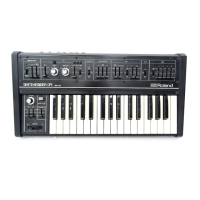Operation
(cont)
Sustain
The Sustain slider has
already been referred
to
in
the
Decay
section,
and is not a
time
function but
the
level
to
which the Decay
will fall while any key
is still held
down. With the
Sustain
at
'0',
any
Attack/Decay
combination will end in silence no
matter
how long
a
key is
held. With the Sustain
level set at
'10',
a
note
will
stay
at
full volume from
the instant the
Attack is
complete
until
the
key is
released
—
virtually
cancelling
the Decay
function
and giving the note
no
'internal' change
in shape
during its length.
15
By using different combinations of
the Attack
and
Decay lengths and Sustain level,
sophisticated
shaped
notes are
possible such
as
the extra
emphasis at the beginning of
a
string
down bow,
held brass notes, or the burst
at the beginning
of
percussive instrument
notes such
as
piano.
See
the
Application and Patch sections tor specific
uses
of
the Sustain function
Release
The
Release slider
control is
responsible
for
the
note from
the instant
the key
is released
—
taking
over from
the Attack, Decay
and
Sustain which end
at
the
point as we
have seen.
Leave the A, D
& S
all
set at about
'3'
and set
the Release at
'10'.
Hold
a note long enough so
that the
Attack
and
Decay
are completed
and
your note is resting on
the
Sustain level.
When the key
is released
the
note will
continue,
gradually
fading
to
silence.
Repeat this procedure,
lowering the Release time
in
several
steps
until you
are down
to the
abrupt,
instant Release
at
'0'
that
we experienced before.
Leave
the Release slider at
'2'
or
so
for
a
pleasing,
relatively
short
Release, set the Attack and Decay
sliders
at
'6'
and experiment with short
notes,
inter-
rupting
the
Attack and Decay cycles
at
various
points. Here
you
will discover
the full extent
of
the
extra
keyboard
control
mentioned
at
the end
of
the
Attack
description.
Pressing
and releasing a single
key
produces a Gate
beginning
and ending at
those respective
moments. The Release function
will begin
when the Gate ends
—
regardless
of
when it ends.
The Release, then, will follow the
Gate
logic
as
described
—
in legato
playing,
the
Gate
will begin at the
first note and
end the
first
instant
that all keys
are raised. Practice with this
principle and patches
presented
within
this
manual
to play the
SH-09's
keyboard
to a
major advantage
for
added
realism and
control.
Envelope Modes
The SH-09 Envelope may
be
activated by the
keyboard in three
different ways, each with its own
advantages.
The Envelope Mode
switch
lets you
choose between Gate and
Trigger,
Gate,
and
LFO
options. Your SH-09 gives
you
this choice to
give
you the
ultimate in flexibility and
expression in all
applications.
With the Envelope mode selector
in the
Gate
&
Trigger
position, individual
spaced
notes will
each
have
a complete
envelope shape
of
its
own. When
legato
playing
is used
(overlapping the playing
of
two or
more keys)
new notes
will re-attack from
whatever point
they
had reached
in the notes they
are interrupting. This principle
follows
the
Trigger
logic: new keys pressed
on
the
left will re-attack
while
new keys to
the right
will
not until any
keys
to the
left are released.
This
type
of playing allows
very fast playing in
which totally clean keyboard
technique is not
absolutely necessary, and is
par-
ticularly useful for sounds
with
a
quick attack and
a
relatively low sustain
level. Check the Sustained
Guitar patch
give later for
a
typical example.
Placing the
Envelope mode selector in the Gate
position offers
a
second option.
Individually
spaced
notes will each have a complete
envelope shape.
Legato playing
will produce new pitches (accord-
ing
to
the
KCV logic described earlier),
but
the
envelope will continue on as
if
it were one
long
note.
In
a patch
such
as
the Shuffle Bass shown
later, this allows you to
produce
the
sound of
re-
fretting
notes
without re-plucking them.
When
you
place
a
clean break between
notes
they
will
re-
attack.
Legato playing
will
allow
the series of notes
to
continue
to fade. Practice
using this
technique
will give
good control and
a sound with
variety and
interest
—
an area where
most
other synthesizers
fall short.
Some
sounds will need
a detached
keyboard tech-
nique
to
sound their
best.
In
a
string
instrument
patch, for instance, either
the Gate
or the
Gate
and
Trigger
positions
played legato will
lose
the
realism
that
would be generated
by
a
fresh
release
and
attack from
detached playing.
Also, in
legato play-
ing
a
'click'
will be heard
as the notes
switch ins-
tantly to new
pitches. Experience
will show
you
which of
these two mode
options
to choose, but
there is no
substitute for developing
a keyboard
technique
where light playing
and
at least
a
minimum
separation
between
notes is
possible.
The Envelope
mode labelled
LFO is
controlled both
from
the Keyboard
Gate and the
Modulator
LFO.
When
a
key is
depressed, the
Keyboard
Gate
will
allow
the Modulator LFO
to repeatedly
activate the
Envelope
at the speed
set by the Modulator
Rate
control,
and indicated
on the
associated
LED
indicator.
This repeating Envelope
will
continue as
long
as
any key
is held down,
ending
the instant
that all keys are
released according
to the
Keyboard
Gate logic
explained earlier.
This mode
is
especially useful for
instruments
needing
fast
continuous
repeating notes
such
as the
mandolin,
banjo
or
marimba.

